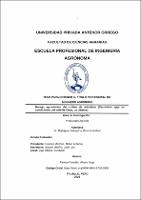Manejo agronómico del cultivo de arándano (Vaccinium spp) en condiciones del valle de Chao, La Libertad

View/Open
Download
(application/pdf: 4.185Mb)
(application/pdf: 4.185Mb)
Date
2021Author(s)
Rodríguez Marquina, Ricardo Rafael
Metadata
Show full item recordAbstract
En la actualidad, en Perú se viene incrementando el área asignada para
cultivar arándano, predominando la variedad Biloxy en las superficies
productivas; sin embargo, existen también nuevos cultivares que generan
interés debido a que muestran buenas respuestas de producción y calidad
en la fruta, en el ambiente agroclimático del valle de Chao, en los terrenos
que encontramos en la zona del valle de chao tenemos que todos son
terrenos áridos y de muy poco o nulo aporte de materia orgánica que es
necesaria para el cultivo del arándano, en este escenario nace la necesidad
de una buena preparación de terreno para mejorar las propiedades físico químicas del suelo y tener mejores resultados en la instalación y producción
del cultivo. En la zona en mención, se dio inicio al desarrollo del proceso de
cultivar arándano, primero instalando el plantío, acto seguido trasplantando
las siguientes variedades de arándano: Biloxy, Emerald, Snow chasser,
Spirng High y Ventura; variedades que requieren pocas horas – frío.
Después de analizar el factor económico y ambiental en el cual se iba a
trabajar se diseñó la plantación; la conducción agronómica para finalmente
cosechar el arándano, con parámetros de calidad, debiendo ser
correctamente seleccionados y empaquetados para su entrega a mercados
internacionales, en la campaña 2020/2021 nuestro país contaría con
14.789 hectáreas de arándano a nivel nacional, es decir 35% más que en
la campaña pasada donde existían 10.936 hectáreas., según proyectó la
Asociación de Productores de Arándanos del Perú (ProArándanos). Se
estima que en unos años llegaremos a las 20 mil hectáreas de arándanos,
eso será muy fuerte y marcará mucho dentro de lo que son cultivos de
exportación no tradicionales At present, in Peru the area assigned to cultivate blueberries has been
increasing, with the Biloxy variety predominant in the productive areas;
However, there are also new cultivars that generate interest because they
show good production and quality responses in the fruit, in the agroclimatic
environment of the Chao valley.In the lands that we find in the Chao Valley
area, we have that all are arid lands and with very little or no contribution of
organic matter that is necessary for the cultivation of blueberries, in this
scenario the need for a good preparation of land is born. improve the
physical-chemical properties of the soil and have better results in the
installation and production of the crop. In the area in question, the
development of the process of cultivating blueberries began, first by
installing the plantation, then by transplanting the following varieties of
blueberries: Biloxy, Emerald, Snow chasser, Spirng High and Ventura;
varieties that require few hours - cold. After analyzing the economic and
environmental factor in which they were going to work, the plantation was
designed; the agronomic drive to finally harvest the blueberry, with quality
parameters, which must be correctly selected and packaged for delivery to
international markets. In the 2020/2021 campaign, our country would have
14,789 hectares of blueberries nationwide, that is, 35% more than in the last
campaign where there were 10,936 hectares, as projected by the
Association of Blueberry Producers of Peru (ProArandanos). It is estimated
that in a few years we will reach 20 thousand hectares of blueberries, that
will be very strong and will mark a lot within what are non-traditional export
crops
Collections
- Ingeniería Agrónoma [107]

